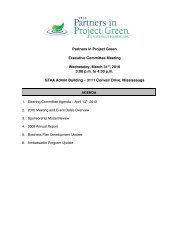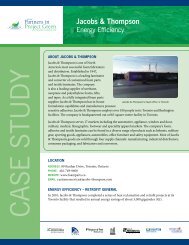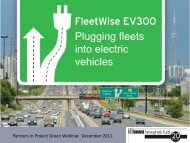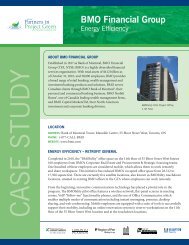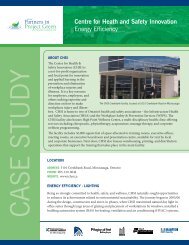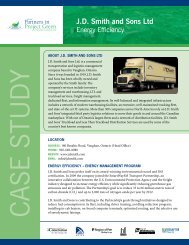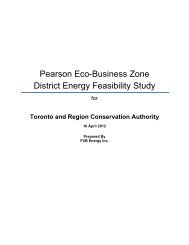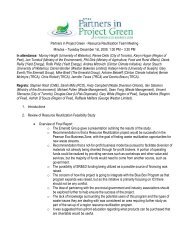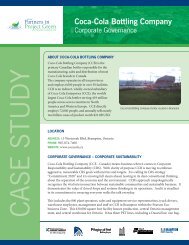Summary Report and Implementation Plan - Partners in Project Green
Summary Report and Implementation Plan - Partners in Project Green
Summary Report and Implementation Plan - Partners in Project Green
You also want an ePaper? Increase the reach of your titles
YUMPU automatically turns print PDFs into web optimized ePapers that Google loves.
Appendix 1: C<strong>and</strong>idate Restoration Sites (cont.)<br />
(also refer to Map 3 – Terrestrial Natural Heritage F<strong>in</strong>d<strong>in</strong>gs <strong>and</strong> Recommendations)<br />
Site<br />
No.<br />
Location Details/Rationale Priority<br />
11 Adjacent to the Canada<br />
Bread factory, south of<br />
Egl<strong>in</strong>ton Avenue, west<br />
of Rakely Court<br />
12 North of the Hewlett-<br />
Packard office build<strong>in</strong>g,<br />
at the corner of<br />
Matheson <strong>and</strong> Spectrum<br />
roads<br />
13 North of Courtney Park<br />
Drive on the airport<br />
grounds, adjacent to<br />
Etobicoke Creek<br />
14 Below Britannia Road,<br />
on the airport grounds<br />
15 East of the term<strong>in</strong>al end<br />
of Luke Road<br />
16 Above Britannia Road<br />
on the airport grounds<br />
17 East of Dixie Road, north<br />
of Courtney Park Drive<br />
18 South of Derry Road,<br />
east of Dixie Road<br />
19 Mount Charles Park,<br />
located at Cardiff<br />
Boulevard <strong>and</strong><br />
Transmark Court<br />
The area is currently an open meadow, likely mowed a few times a year. It lies adjacent to a<br />
mature dry-fresh sugar maple/oak deciduous forest (L4) community that hosts a suite of flora<br />
<strong>and</strong> fauna species of concern. Opportunity exists with<strong>in</strong> this site to significantly <strong>in</strong>crease the<br />
size of this forest patch <strong>and</strong> provide opportunity for area-sensitive species such as wood thrush<br />
(Hylocichla mustel<strong>in</strong>a).<br />
Currently the site appears undeveloped <strong>and</strong> would represent an opportunity for reforestation<br />
that would significantly buffer <strong>and</strong> enhance patch size of the neighbour<strong>in</strong>g forest. This exist<strong>in</strong>g<br />
forest is a fresh-moist oak/sugar maple deciduous forest, an L3 community, with an <strong>in</strong>clusion<br />
of a rare dry-fresh white p<strong>in</strong>e/oak-mixed forest community (L2). Reforestation with<strong>in</strong> this area<br />
would significantly benefit these vegetation communities <strong>and</strong> the suite of rare flora they shelter<br />
(<strong>in</strong>clud<strong>in</strong>g the jurisdictionally rare tw<strong>in</strong>leaf ).<br />
There are several young woodl<strong>and</strong>s here of sugar maple-oak <strong>and</strong> hickory. Both of these<br />
vegetation communities are very rare <strong>and</strong> sensitive, especially with<strong>in</strong> the context of this study<br />
area. There are also many resident L3 <strong>and</strong> L4 flora <strong>and</strong> fauna with<strong>in</strong> these young woodl<strong>and</strong>s. The<br />
exist<strong>in</strong>g forest patch is extremely narrow, therefore exceed<strong>in</strong>gly sensitive to external negative<br />
impacts. Recommendation here is to reforest adjacent l<strong>and</strong>s to improve this community’s<br />
resiliency <strong>and</strong> to significantly <strong>in</strong>crease patch size to benefit resident fauna.<br />
With<strong>in</strong> the site there are two vegetation communities of concern, a fresh-moist black walnut<br />
lowl<strong>and</strong> deciduous forest (L3) <strong>and</strong> a narrow-leaved sedge m<strong>in</strong>eral meadow marsh (L4).<br />
Recommendations for this site <strong>in</strong>clude size <strong>in</strong>creases to the black walnut lowl<strong>and</strong> forest <strong>and</strong><br />
enhancements to wetl<strong>and</strong> habitats with<strong>in</strong> this block.<br />
Along with the black walnut forest mentioned <strong>in</strong> Site 14, this black walnut lowl<strong>and</strong> deciduous<br />
forest is the only L3 community with<strong>in</strong> the immediate airport vic<strong>in</strong>ity. Restoration activities here<br />
would seek to improve both size <strong>and</strong> shape for this forest community via the reforestation of<br />
adjacent l<strong>and</strong>s, where height restrictions at end of runway allow for this. If soil <strong>and</strong> topographic<br />
conditions allow, a wetl<strong>and</strong> creation may be another possibility.<br />
There are several plantations here of ash, poplar <strong>and</strong> black walnut, with a silver maple<br />
understorey. There is also an adjacent reed canary grass m<strong>in</strong>eral meadow marsh. Opportunities<br />
for restoration could <strong>in</strong>clude augmentation of the exist<strong>in</strong>g plantations, with further plant<strong>in</strong>gs<br />
of black walnut <strong>and</strong> ash. There is opportunity to also create silver maple swamp habitat, tak<strong>in</strong>g<br />
advantage of current topography <strong>and</strong> exist<strong>in</strong>g silver maple populations. Further work could<br />
also be undertaken to enhance the reed canary grass meadow marsh with plant<strong>in</strong>gs of native<br />
dogwoods <strong>and</strong> willow shrubs.<br />
Opportunities exist here to connect a willow m<strong>in</strong>eral deciduous swamp populated by native<br />
peach leaf willow (Salix amygdaloides) (L4), with exist<strong>in</strong>g hedgerows conta<strong>in</strong><strong>in</strong>g another rare<br />
feature <strong>in</strong> the GTAA study area—mature trees. These hedgerows also conta<strong>in</strong> another L4 species,<br />
bitternut hickory (Carya cordiformis). Infill plant<strong>in</strong>gs between <strong>and</strong> around these hedgerows, <strong>and</strong><br />
riparian plant<strong>in</strong>gs around exist<strong>in</strong>g wetl<strong>and</strong>s would significantly <strong>in</strong>crease the functionality <strong>and</strong><br />
size of this habitat patch, along with buffer<strong>in</strong>g <strong>and</strong> contribut<strong>in</strong>g to overall biodiversity on site.<br />
Restoration activities could encompass riparian plant<strong>in</strong>gs alongside the creek where several L3<br />
to L4 flora can be found bank side. Reforestation of marg<strong>in</strong>al agricultural l<strong>and</strong>s <strong>and</strong> plant<strong>in</strong>gs to<br />
improve patch size <strong>and</strong> shape are recommended.<br />
There are several forest communities exist<strong>in</strong>g <strong>in</strong> this park, black walnut lowl<strong>and</strong> (L3), ash<br />
lowl<strong>and</strong> (L5) <strong>and</strong> fresh-moist sugar maple hardwood (L5). The maple forest is a very mature<br />
community that supports numerous flora species of concern — a rare feature with<strong>in</strong> the<br />
GTAA study area, north of Highway 401. Recommended restoration activities would <strong>in</strong>clude<br />
reforestation of the adjacent meadow to the north-west of this forest patch to optimize patch<br />
size <strong>and</strong> buffer aga<strong>in</strong>st external negative impacts.<br />
HIGH<br />
HIGH<br />
HIGH<br />
HIGH<br />
MEDIUM<br />
LOW<br />
LOW<br />
MEDIUM<br />
LOW<br />
45



